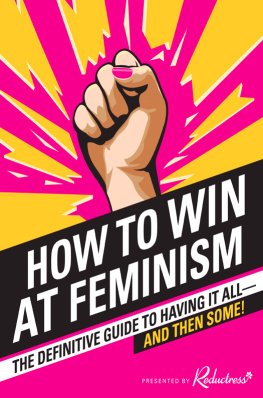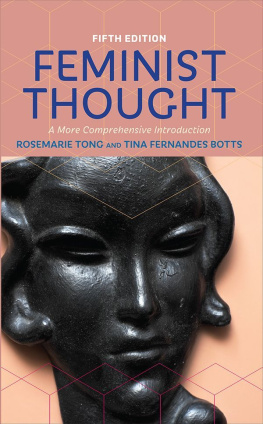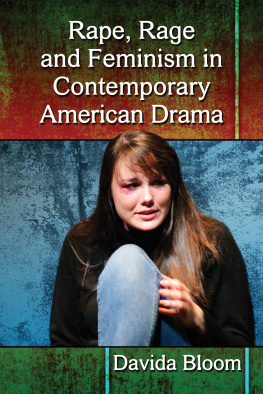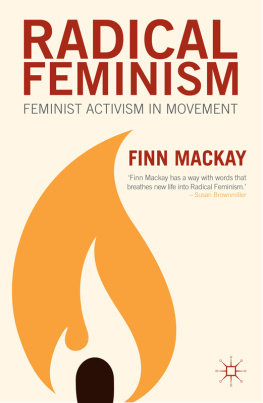Public Women, Public Words
ROWMAN & LITTLEFIELD PUBLISHERS, INC.
Published in the United States of America
by Rowman & Littlefield Publishers, Inc.
An Imprint of the Rowman & Littlefield Publishing Group
4720 Boston Way, Lanham, Maryland 20706
www.rowmanlittlefield.com
12 Hids Copse Road, Cumnor Hill, Oxford 0X2 9JJ, England
Copyright 2002 by Rowman & Littlefield Publishers, Inc.
All rights reserved. No part of this publication may be reproduced, stored in a retrieval system, or transmitted in any form or by any means, electronic, mechanical, photocopying, recording, or otherwise, without the prior permission of the publisher.
British Library Cataloguing in Publication Information Available
Library of Congress Cataloging-in-Publication Data
Keetley, Dawn Elizabeth, 1965-
Public women, public words : a documentary history of American feminism / edited by Dawn
Elizabeth Keetley and John Charles Pettegrew
p. cm.
Includes bibliographical references and index.
ISBN 0-7425-2235-0 (alk. paper)
1. FeminismUnited StatesHistory-18th centurysources. 2. FeminismUnited
StatesHistory19th centurysources. I. Pettegrew, John Charles, 1959.
HQ1410 .K444 2002
305.42'0973dc21 97-3580
Printed in the United States of America
 The paper used in this publication meets the minimum requirements of American National Standard for Information SciencesPermanence of Paper for Printed Library Materials, ANSI/NISO Z39.48-1992.
The paper used in this publication meets the minimum requirements of American National Standard for Information SciencesPermanence of Paper for Printed Library Materials, ANSI/NISO Z39.48-1992.
Preface and Acknowledgments
V OLUMES II AND III OF Public Women, Public Words, released five years after volume I, are different in form and intent. The greater number of documents for much shorter periods of time offer material proof of the proliferation of U.S. feminism during the twentieth century. And because of the diffusion of feminist thought and activism over the last one hundred years, volumes II and III make no real claims to comprehensiveness: a great many canonical feminist texts can be found in the pages that follow, but others are missingdue to copyright law, permissions costs, their accessibility in other volumes, and the fact that we decided early on that it would be impossible to include all the periods major works in two volumes.
In continuing our focus on the relationship between feminist thought and action, volumes II and III present documents that locate different institutions through which womens movements for equality and liberation occurred. While public writing and speech-making remain paramount, we also looked into newer media such as Hollywood, television, and the Internet. The result is a somewhat impressionistic account of U.S. feminism, with some important topics such as pornography, womens health and medicine, abortion, and women in law and religion given relatively little attention. Late-twentieth and early-twenty-first-century American feminism has been a dispersed and uncertain undertaking: volume III contributes an early effort toward its historicization.
A note on the text: obvious typographical errors in the original documents have been corrected, as in a misspelled word or name; for some of the older documents, footnotes have been omitted when their content was deemed unnecessary to understanding or appreciating the document.
The better part of this projects work was done at the University of Wisconsin, Madison, and we therefore want to thank the staffs at the University of Wisconsin Memorial Library and especially at the State Historical Society of Wisconsin Library and Special Collections. Also helpful were the librarians at Stanford Universitys Green Library. The speedy work of Pat Ward and others in Lehigh Universitys Inter Library Loan office proved invaluable to the completion of volumes II and III.
The latter volumes also benefited from the work of a number of Lehigh research assistants: Jonathan Hagel, Robert Nill, and Suzanne Shriverthanks to all. Janet Walters of Lehighs history department also helped considerably in handling these volumes seemingly endless printing and correspondence. And John Lennon, Chris Robe, and Lisa Vetere contributed timely proofreading for volume II.
Mary Fiorenzas copyediting and intelligently close reading made significant improvements to the section introductions to volumes II and III.
Over the past nine years of work on Public Women, Public Words, several friends, colleagues, and teachers have offered help, advice, and inspiration. Thank you Paul Boyer, Ellen DuBois, Susan Stanford Friedman, Linda Gordon, Daniel Horowitz, William Shade, and Landon Storrs.
We are indebted to Gregory Britton, John Kaminski, and Madison House Publishers for picking up this project when it was little more than an outline on a napkin; after Rowman & Littlefield took over production of the last two volumes, Mary Carpenter, Janice Braunstein, and Laura Roberts have seen it through with great patience, efficiency, and consideration.
We have made a good faith effort to contact those who have rights to the documents printed here. We would like to thank everyone who responded and who granted permission.
INTRODUCTION
Splitting Differences:
Conceiving of American Feminism
T HIS COLLECTION OF DOCUMENTS traces the development of feminist thought from colonial North America through U.S. political and popular culture of the late twentieth century. A primary goal of the book is to offer an intellectual history of American feminism: that is, to examine not only the conceptual composition of the subject, but also to study how women have used ideas practically to gain power within specific historical circumstances. We understand feminism as a process, an activity, a social movement that has flourished through the polypragmatic expression of womens needs in public-political discourses and institutions. Feminism describes enactments of thought meant to improve socialsexual relations.
Overview
Many of the following documents reflect our interest in revealing the confluence between thought and action in American feminism. For example, Frances Wrighta founding figure of the early-nineteenth-century womens rights movementnot only wrote and lectured throughout the 1820s but also established the utopian community of Nashoba in Tennessee. Maintaining that mankind must reasonably hesitate to receive as truths, theories, however ingenious, if unsupported by experiment, Wright instituted greater freedom for women at Nashoba than any other American community of its time, nullifying all marriage laws and further declaring that no woman entering the community would forfeit individual rights and her independent existence. Insisting on liberty and equality for every individual, Wright infused immediate substance into these ideals by founding Nashoba.
A second principal goal of this collection is to represent the diversity of American feminism. Rather than rendering feminism as the battle of a homogeneous group of women in the name of a single cause such as suffrage or equal rights with men, we discuss feminism specific to various races, ethnicities, classes, regions, and sexualities and seek to illuminate the distinct interests that have sprung from these social groups. We document, in other words, a history that has been varied, multiple, and far from unified. But even while concentrating on the contested nature of American feminism, we do not want to rule out the possibility of locating shared concerns and common actions among women of different orientations. Our selection of texts attempts to establish a middle ground between arguments for, on one side, the dispersion of an infinite number of feminisms and, on the other side, the overarching unanimity of American feminism.












 The paper used in this publication meets the minimum requirements of American National Standard for Information SciencesPermanence of Paper for Printed Library Materials, ANSI/NISO Z39.48-1992.
The paper used in this publication meets the minimum requirements of American National Standard for Information SciencesPermanence of Paper for Printed Library Materials, ANSI/NISO Z39.48-1992.